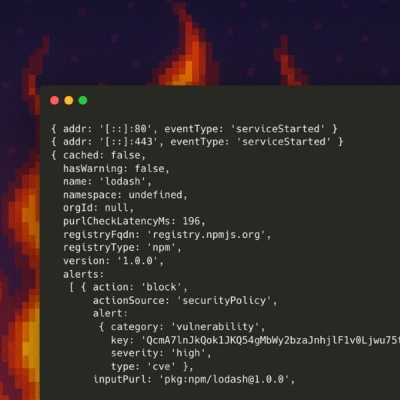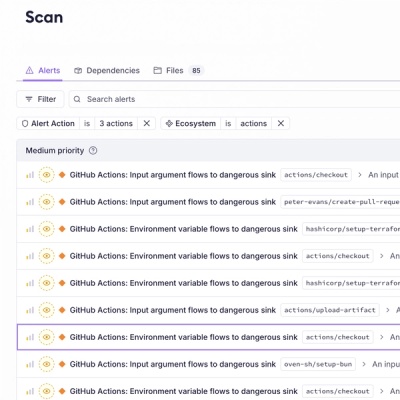
Product
Introducing Socket Firewall Enterprise: Flexible, Configurable Protection for Modern Package Ecosystems
Socket Firewall Enterprise is now available with flexible deployment, configurable policies, and expanded language support.
@smile_identity/smart-camera-web
Advanced tools
WebComponent for smartly capturing images on the web, for use with SmileIdentity
SmartCameraWeb is a Web Component designed to capture images including selfies, liveness images, and ID Document images for use with SmileIdentity. It interfaces with the Server to Server libraries, serving as a user interface client.
Explore an example full stack integration using our NodeJS library.
To integrate SmartCameraWeb, follow these steps:
Supported Server to Server Libraries include:
Note: Code samples in this documentation utilize the NodeJS Server to Server library.
You can install via NPM or directly include it from our CDN.
npm install @smile_identity/smart-camera-web@<version>
Then, in your VueJS, AngularJS, or React component:
import '@smile_identity/smart-camera-web';
<script src="https://cdn.smileidentity.com/js/<version>/smart-camera-web.js"></script>
For instance:
<script src="https://cdn.smileidentity.com/js/v1.0.2/smart-camera-web.js"></script>
After installation and necessary imports:
Add the desired markup to your page/component:
For Selfie Capture / Liveness Images:
<smart-camera-web></smart-camera-web>
For Selfie Capture / Liveness and ID Images:
<smart-camera-web capture-id></smart-camera-web>
Initially, you'll see this image:

After granting access, the capture screen appears:

Upon capturing a selfie, you'll reach the review screen:

If the capture-id attribute is used, additional screens include:


Handle the imagesComputed event:
When the user approves the captured image, an imagesComputed event is dispatched. The event returns a CustomEvent payload in e.detail.
Here's a script example to handle the event and send data to a backend endpoint:
<script>
const app = document.querySelector('smart-camera-web');
const postContent = async (data) => {
const options = {
method: 'POST',
headers: {
'Content-Type': 'application/json',
},
body: JSON.stringify(data),
};
try {
const response = await fetch('/', options);
const json = await response.json();
return json;
} catch (e) {
throw e;
}
};
app.addEventListener('imagesComputed', async (e) => {
try {
const response = await postContent(e.detail);
console.log(response);
} catch (e) {
console.error(e);
}
});
</script>
The provided backend endpoint uses the NodeJS Server to Server library and ExpressJS:
const express = require('express');
const { v4: UUID } = require('uuid');
if (process.env.NODE_ENV === 'development') {
const dotenv = require('dotenv');
dotenv.config();
}
const SIDCore = require('smile-identity-core');
const SIDSignature = SIDCore.Signature;
const SIDWebAPI = SIDCore.WebApi;
const app = express();
app.use(express.json({ limit: '500kb' }));
app.use(express.static('public'));
app.post('/', async (req, res, next) => {
try {
const { PARTNER_ID, API_KEY, SID_SERVER } = process.env;
const connection = new SIDWebAPI(
PARTNER_ID,
'/callback',
API_KEY,
SID_SERVER,
);
const partner_params_from_server = {
user_id: `user-${UUID()}`,
job_id: `job-${UUID()}`,
job_type: 4, // job_type is the simplest job we have which enrolls a user using their selfie
};
const {
images,
partner_params: { libraryVersion },
} = req.body;
const options = {
return_job_status: true,
};
const partner_params = Object.assign({}, partner_params_from_server, {
libraryVersion,
});
const result = await connection.submit_job(
partner_params,
images,
{},
options,
);
res.json(result);
} catch (e) {
console.error(e);
}
});
// NOTE: This can be used to process responses. don't forget to add it as a callback option in the `connection` config on L22
// https://docs.usesmileid.com/further-reading/faqs/how-do-i-setup-a-callback
app.post('/callback', (req, res, next) => {});
app.listen(process.env.PORT || 4000);
This approach can also be achieved using other Server to Server libraries.
SmartCameraWeb is compatible with most JavaScript frameworks and libraries. For integration with ReactJS, refer to this tutorial due to React-WebComponents compatibility issues.
Tested on the latest versions of Chrome, Edge, Firefox, and Safari. If compatibility issues arise on certain browsers, please notify us.
Note: smart-camera-web.js is generated from src/ using esbuild. To make changes, edit the source files and run npm run build to generate the new smart-camera-web.js file.
FAQs
WebComponent for smartly capturing images on the web, for use with SmileIdentity
The npm package @smile_identity/smart-camera-web receives a total of 496 weekly downloads. As such, @smile_identity/smart-camera-web popularity was classified as not popular.
We found that @smile_identity/smart-camera-web demonstrated a healthy version release cadence and project activity because the last version was released less than a year ago. It has 11 open source maintainers collaborating on the project.
Did you know?

Socket for GitHub automatically highlights issues in each pull request and monitors the health of all your open source dependencies. Discover the contents of your packages and block harmful activity before you install or update your dependencies.

Product
Socket Firewall Enterprise is now available with flexible deployment, configurable policies, and expanded language support.

Security News
Open source dashboard CNAPulse tracks CVE Numbering Authorities’ publishing activity, highlighting trends and transparency across the CVE ecosystem.

Product
Detect malware, unsafe data flows, and license issues in GitHub Actions with Socket’s new workflow scanning support.